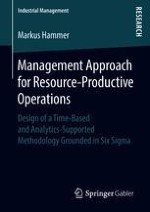Markus Hammer investigates a time-based and analytics-supported operations management approach. He explores five perspectives: 1) the needs of industry, in particular manufacturing in process industries, 2) the impact of digitization, with focus on Big Data and analytics, 3) the management of operations through time-based performance metrics, 4) how operations improvement methods and advanced process control help achieve resource-productive operations and 5) learning from practice based on two empirical case studies. The author conceives, explains, and tests an implementation methodology. The final case study proves that the developed implementation methodology works in practice.
